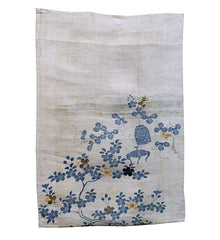A Beautiful Fragment from a Hemp or Ramie Kimono: 18th Century
19 1/4" x 13 1/2", 49 cm x 34 cm
Shown here is a treasure, something of an indication of the kind of masterful weaving, dyeing and needlework that was done--quite literally--centuries ago in Japan and is now lost to time.
This is a fragment from a katabira or a kind of hyper-elegant, unlined summer garment worn by women in the upper echelon of Japanese society. Katabira of this era for samurai women are distinctive in their decoration and usually had a kind of distinguishing "look" about them: this fragment beautifully captions the decorative and integral essence of this kind of katabira.
It is woven from the finest asa or bast fiber, more than likely Echigo jofu, which is super fine, snow bleached ramie cloth which is one of the glories of the Japanese loom. Once this superior cloth was woven in Niigata prefecture it was most likely sent to Kyoto where the dyed, couched and embroidered decoration were applied.
Yuzen dyeing produced the beautifully drawn chrysanthemums which grace the design to the left of the intricately hand embroidered folding fan.
The scene depicted here is imagined. It shows a heavily blooming, gracefully arched cherry branch, some scattered ivy and its tendrils, some billowing clouds which suggest an endless horizon. Two objects are also depicted.
The gold couching which was relegated to define the softly lapping surf is fairly unbroken and beautifully done. The purple color is achieved by dyeing in gromwell root while the blue is, of course, indigo.
The cloth of this fragment is still beautifully white in appearance and any mottling of the white color that is seen in the photos here is just an unfortunate trick of light: the undyed cloth is beautifully clear. The embroidery is all in good condition with the exception of three flowers where the silk floss seems intentionally picked out and a vestige now remains.
This is a spectacularly beautiful fragment of a super luxurious cloth from what had to have been a remarkably fine kimono from the late 18th century.
Recommended--and how beautiful would this look framed.


